Search results for 'networking' (14)

If your chamber membership is gathering dust because you don't enjoy networking events, you're missing out on significant value hiding in plain sight. While mixers and ribbon cuttings get the spotlight, your membership includes strategic resources that can solve real business problems, even for those of us who hate “working a room.” Your Chamber as Problem-Solving Partner Before hiring expensive consultants or spending hours researching solutions or attending City Council meetings with time you don’t have, tap into your chamber's institutional knowledge. Most chambers field dozens of questions weekly from businesses facing similar challenges. Need a reliable commercial insurance broker? Wondering about local permit requirements? Looking for employee benefits providers? Your chamber staff has likely connected ten other businesses with exactly what you need in the past month alone. A simple phone call can save you days of research and connect you with pre-vetted resources. Leverage Collective Buying Power Your chamber membership often includes access to group rates on essential services. Health insurance, payment processing, shipping discounts, office supplies, and advertising opportunities frequently come with member pricing that can save thousands annually. Many business owners never explore these benefits because they assume switching providers is complicated. Start with one area—perhaps credit card processing fees or shipping costs—and request a comparison quote through your chamber's endorsed programs. The savings often pay for your membership several times over. - Medical Plan available to Chamber Members through Aetna Strategic Visibility Without the Small Talk Hate networking events but still need visibility? Most chambers offer alternative exposure opportunities: member spotlights in newsletters, social media features, directory listings with SEO benefits, an article in their destination guide, and quote opportunities for press releases. Volunteer for a committee that meets during business hours rather than evening mixers. You'll build deeper relationships with fewer people while contributing your expertise. Economic development, public policy, events, or education committees often need people and meet in formats more comfortable than cocktail parties. - Your membership comes with an online listing that has a customizable landing page, complete with ability to rate and review. However, if your current membership level does not include this, feel free to contact us to discuss an upgrade: Office@llchamber.com - Interested in volunteering? Let us know: Office@llchamber.com . We’re always looking for people willing to lend a hand! - We’d love to hear your praise for the Chamber—send us a short quote!. Interested? You know the email: Office@llchamber.com . - Join our 2026 Leadership class and spend time with a select group of up and coming community leaders. Currently accepting applications through December 1. Make Your Voice Count Chambers actively advocate on behalf of businesses with local and state government. Your membership gives you a direct channel to influence policies affecting your bottom line from zoning regulations to tax policies. Most chambers solicit member input on advocacy priorities but rarely hear from the majority of their membership. When your chamber sends advocacy surveys or requests feedback, take ten minutes to respond. Your specific challenges and stories give chamber leaders concrete examples when they're meeting with elected officials. -Check out our Government Affairs Committee or join them, second Thursdays monthly, 9-10AM, at the Chamber. Playlists of past events also available on YouTube ! - Check out our Military Affairs Council- they meet monthly, first Tuesdays at noon, at the conference room in Fairfield Inn & Suites. They also have quarterly MAC socials. Sign up for our December 10 th social (free!) or contact us to discuss hosting one: Office@llchamber.com. Your chamber membership is a toolkit, not a ticket to parties. Identify two or three benefits aligned with your current business needs and commit to using them this quarter. The return on investment is there. You just need to claim it. - We are also collecting survey answers to better serve our community- please let us know! It’s short (we promise!) and will enter you for a chance to win a “LeavenworthIt” Swag bag. Read More: - 10 Ways to Get the Most from your Chamber Membership - How to Build Business Connections (Even if You Hate Networking) - Local Business Partnerships Strengthen Communities and Drive Growth - Your Chamber Listing Matters More Than Ever! ----------------- Christina Metcalf is a writer/ghostwriter who believes in the power of story. She works with small businesses, chambers of commerce, and business professionals who want to make an impression and grow a loyal customer/member base. She loves road trips, hates exclamation points, and is currently reading three books at once. _______________________________________ Medium: @christinametcalf Facebook: @tellyourstorygetemtalking Instagram: @christinametcalfauthor LinkedIn: @christinagsmith

Think of the person in your circle (even tangentially) who comes to mind when you read the word, “boring.” Who is it? Now ask yourself why you think they’re boring. It’s your opinion, right? Maybe all they do is talk about sports or maybe when you’re talking about sports, they want to talk about the weather. Perhaps they’re not boring at all. Maybe it’s just that you don’t have mutual interests. If your business is struggling to attract loyal customers, it might be that you’re suffering from the same thing. Maybe you’re talking about things your ideal customer doesn’t care about. It’s time to get their attention and become much more interesting to them. The Problem with Basic Marketing The problem many businesses face when it comes to their marketing message isn’t that they are inherently boring. It’s that what they choose to make their message is not something that appeals to their ideal audience. To captivate that audience, you need to first understand who the audience is, then present something that they need/want, and make that solution plausible/believable. But sadly, most businesses and professionals describe their services in generic ways that sound dreamy but completely inactionable or boring such as: A life coach who writes, “I help people follow their dreams.” Or a bakery that posts, “We sell cookies.” Why Generic Messaging Falls Flat Now before you argue, “But it’s what we do,” consider this: when was the last time you searched, “How do I follow my dreams?”? While you don’t have to go into long descriptions about what you do and how you do it, you do need to help your ideal client think to themselves, “That’s what I need.” It’s time to tighten up your marketing message. 1. Identify who you’re speaking to and be specific. Is it moms? Doctors? Students? Who will see the most help from your offerings? 2. Solve a problem they already have. Marketing your product or service will be so much easier if you’re selling something they already know they need. 3. Use language that fits what they’re looking for. Again, very few people are googling, “How do I follow my dreams?”. 4. Show how you can help them get what they want. Your customers have needs, wants, and struggles. They need to trust you understand what that is and can help them. 5. Line up testimonials that speak the same language. If you go through all the work to craft your marketing message, you want to use testimonials that reinforce it. So, let’s put that all together. Remember the life coach who helped people follow their dreams? We’re going to transform that message from meh to mesmerizing. Step 1. Identify the audience Instead of using the generic “people,” the life coach drills down to the realization she works best with mid-career professional women who feel stuck in unfulfilling jobs. Step 2. Solve a problem they already have Their problem isn’t “I can’t follow my dreams.” It’s “I’m burned out in my career and don’t know how to pivot without starting over.” Step 3. Employ the language they’re actually using Her ideal client is more likely searching for phrases like “career change at 40,” “how to find a meaningful job,” or “get unstuck in my career” than “follow my dreams.” Step 4. Show how you can help them get what they want These professional women don’t just want “dreams.” They want clarity, confidence, and an actionable plan to shift into work that lights them up and pays the bills. Step 5. Align testimonials Instead of posting a generic “she helped me follow my dreams,” a stronger testimonial would read something like: “I went from dreading Mondays to launching a consulting business I love. She gave me the tools to make the leap with confidence.” And you could get a testimonial like that by asking a successful client, “What’s changed in your life after working with me? Where were you before and where are you now?” That leads the client into formulating something much more substantial than, “She helped me so much.” Are you ready for the revamped marketing message/elevator pitch? Instead of “I help people follow their dreams,” it’s now… “I help professional women in their 40s who feel stuck in unfulfilling careers gain the clarity and confidence to pivot into work they love without sacrificing income or starting from scratch.” Hear the difference? Now we know exactly who can benefit. There’s no mistaking it and anyone thinking of giving this life coach a referral knows who she’s looking to work with. Those few simple words transform the original vague promise into something specific, problem-solving, and benefits driven. And that means people hearing it and reading it will know when they are the target audience. READ MORE: Are You Accidentally Repelling Perfect Customers? Fast-Track Trust: How to Win Customers Quickly Helping Customers Move Past "Let Me Think About It" ------------------------- Christina Metcalf is a writer and women’s speaker who believes in the power of story. She works with small businesses, chambers of commerce, and business professionals who want to make an impression and grow a loyal customer/member base. She is the author of The Glinda Principle , rediscovering the magic within. _______________________________________ Facebook: @tellyourstorygetemtalking Instagram: @christinametcalfauthor LinkedIn: @christinagsmith
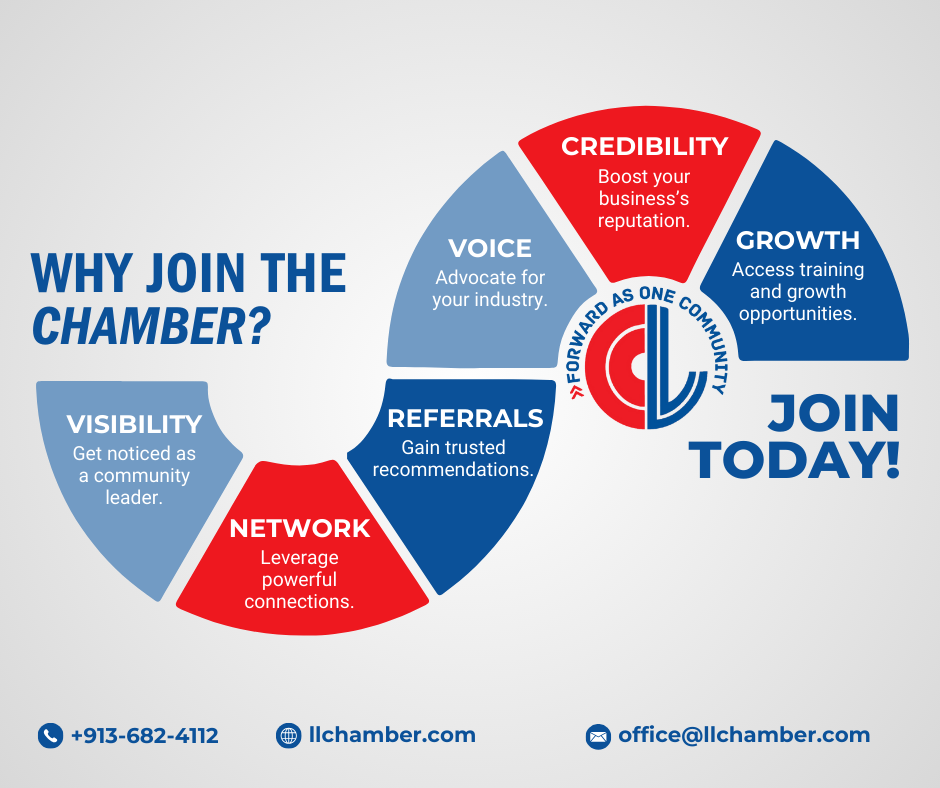
You’ve probably heard a lot about how AI is changing everything, especially how people search for local businesses. Tools like ChatGPT, Google’s Gemini, and Microsoft’s Copilot are being used every day to answer questions like, “Who’s the best roofer in town?” or “Where can I find a local accountant I can trust?” And guess where these tools look for answers? Trusted, local sources, like your chamber of commerce. That means your chamber listing isn’t just about visibility anymore. It’s also about credibility. When your business is featured on the chamber’s website, you’re getting more than a backlink with hundreds of dollars. You’re being associated with a respected, established source of local business information. That sends a powerful signal, not just to Google, but to the AI tools that are shaping how people find and choose who to do business with. This kind of trust is hard to build on your own. The chamber helps you shortcut that by putting your business in a position of authority. It’s one of the most cost-effective ways to improve your online reputation and as AI continues to grow, that value will only increase. If you’re already a member, make sure your profile is current and complete. If you’re not yet a member, this is one more reason to join . The future of search is changing fast. Being part of the chamber means you don’t have to keep up with every trend because we’re already doing that for you. Additional Information: Are you a new business? Already budgeted your expenses for the year? We've created a new opportunity to be included in our online directory. Visit our Get Listed page to learn more!
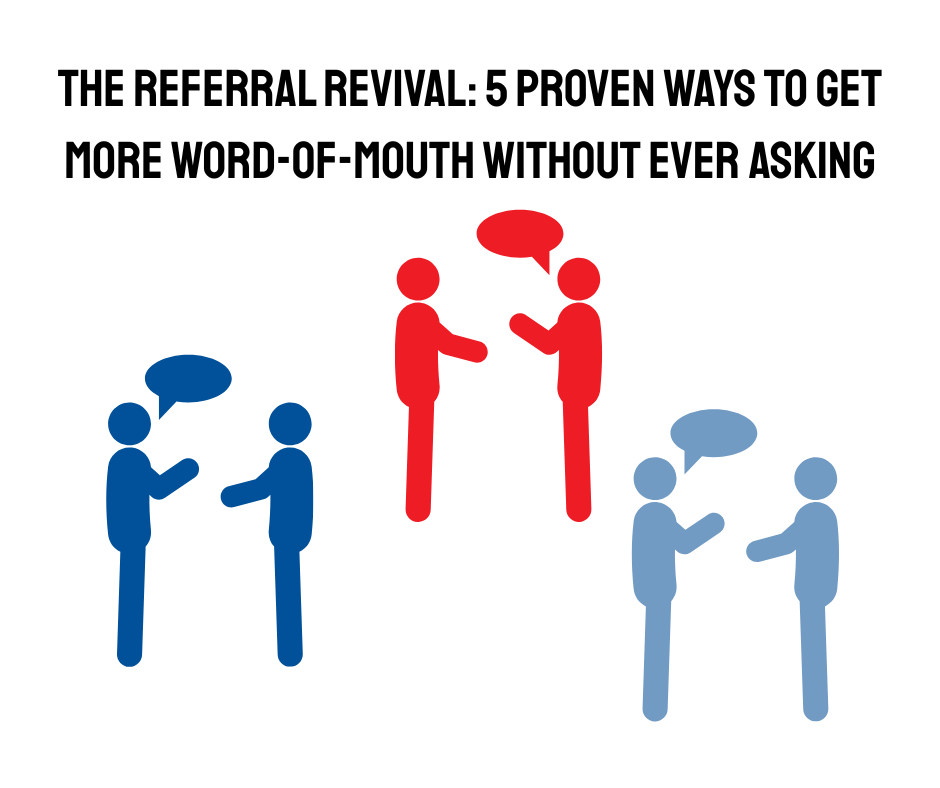
Wow your customers. Exceptional service sparks natural buzz. Seed the idea. Subtle cues make referrals more likely. Give to get. Reciprocity drives more introductions. Make sharing easy. Equip clients with shareable content. Recognize your champions. Public thanks reinforces behavior. 615 words ~ 3 min. read In a world saturated with marketing messages, word-of-mouth remains one of the most powerful business growth tools. Yet asking for referrals can often feel pushy or awkward. The good news: it’s possible to spark more referrals—organically—without ever making a direct ask. Here’s how to build a referral engine that runs on generosity, excellence, and subtle nudges. Wow Your Customers It all starts with the experience. When customers are truly impressed—whether through speed, attention to detail, or delightful service—they naturally want to tell others. Prioritize consistency and small touches that surprise people. It’s these micro-moments that turn satisfied customers into raving fans. Make Sharing Easy Equip your customers with materials they’ll actually want to pass along. This could be helpful blog posts, visual guides, short videos, or checklists—anything that reflects your expertise and is easy to forward. Think of these as “conversation starters” your customers can use to talk about you without the awkwardness. READ MORE: Customer Referrals Are Contagious by Harvard Business Review Seed the Idea Gently You don’t need to ask for referrals outright—but you do need to make it known that they matter. In your email signature, on your invoices, or in post-project wrap-ups, include a line like: "Many of our best clients come from referrals. Thank you for spreading the word!" This keeps referrals top of mind while preserving the tone of appreciation. Give to Get Referrals are a two-way street. Proactively refer your clients, partners, and vendors when you can. When others see you championing their work, they're more inclined to do the same for you. This builds goodwill and a sense of mutual investment. READ MORE from Forbes on the power of reciprocity in business Recognize Your Champions Gratitude is a multiplier. When someone sends a new client your way, acknowledge it right away. A handwritten note, a small gift, or a public thank-you can make your advocates feel valued—and likely to refer again. The goal isn’t to incentivize; it’s to appreciate. Recognition cements the behavior you want more of. Bottom Line You don’t need a slick script or a referral program to grow through word-of-mouth. By focusing on service excellence, subtle cues, generous networking, and authentic gratitude, you create an ecosystem where your customers want to talk about you. Organic referrals are not just a bonus—they’re a reflection of how well you’re doing the fundamentals. --- The Leavenworth-Lansing Area Chamber of Commerce is a private non-profit organization that aims to support the growth and development of local businesses and our regional economy. We strive to create content that not only educates but also fosters a sense of connection and collaboration among our readers. Join us as we explore topics such as economic development, networking opportunities, upcoming events, and success stories from our vibrant community. Our resources provide insights, advice, and news that are relevant to business owners, entrepreneurs, and community members alike. The Chamber has been granted license to publish this content provided by Chamber Today, a service of ChamberThink Strategies LLC.

Let’s be real. Elevator pitches can feel like a late-night infomercial–a robotic recitation of what your business does with an added exclamation point at the end. But for business owners and sales professionals, every interaction is an opportunity. A truly effective elevator pitch transcends mere information delivery. It's about forging genuine connections that can blossom into leads, partnerships, and lasting relationships. It's about making those precious few seconds count, not just for what you say, but for how you make the other person feel. What most people get wrong in their elevator pitch is that they make it sound like a commercial and all about them, when it should be about your audience. Forget the rigid templates and the pressure to cram every detail into a thirty-second spiel. This isn’t about broadcasting; it’s about initiating a conversation. The key lies in shifting your focus from simply explaining your business to creating a spark of interest and establishing a human connection. If you take nothing else from this article know that: the pitch must ignite interest The Psychology of Connection in Brief Interactions Humans are wired for connection. Even in brief encounters, we subconsciously seek common ground, shared values, and genuine interest. Your elevator pitch should tap into this innate desire. Instead of launching into a list of features and benefits, start with a relatable problem you solve or a shared passion that drives your business. Think about your ideal client or contact. What are their pain points? What are their aspirations? Craft an opening that acknowledges their world and subtly positions your business as a potential solution or a valuable resource. This approach immediately makes the interaction less transactional and more empathetic. Storytelling Elements That Resonate While quick is crucial, weaving in a concise narrative “elevates” your pitch. Instead of saying, “We offer marketing solutions,” try something like, “I help small business owners who are overwhelmed by social media finally find a consistent way to connect with their customers and grow their brand. I saw my own sister struggle with this, and that’s why I started [Business Name].” This personal touch and the hint of a story make your pitch more memorable and relatable. Focus on the why behind your business. What motivates you? What impact do you hope to make? Sharing a sliver of your passion can create an emotional resonance that facts and figures alone can't achieve. Tailoring Pitches to Different Personality Types Not everyone responds to the same approach. Observe the person you're speaking with. Are they direct and results-oriented? Focus on the tangible benefits and your track record. Are they more relationship-focused? Emphasize collaboration and shared values. Having a few variations of your pitch allows you to adapt to different personalities and contexts. Practice delivering each version so it feels natural and authentic, rather than forced. The Importance of Active Listening Post Delivery Your elevator pitch isn't a monologue; it's the opening line of a potential dialogue. Pay close attention to the other person's reaction. Are they asking questions? Are they nodding in understanding? Are they looking over your shoulder to be bailed out of the conversation the moment they see someone they know? Use their cues to guide the conversation. Be prepared to elaborate on specific points that pique their interest. This shows you're genuinely engaged and interested in their needs, not just delivering a pre-rehearsed script. A thoughtful question in return can further deepen the connection and open doors for future interaction. Ultimately, a successful elevator pitch is less about perfection and more about authenticity. It's about conveying your passion, highlighting your value, and making a genuine connection in a short amount of time. By focusing on building rapport and leaving a lasting impression, you transform a brief encounter into a potential steppingstone for long-term growth and meaningful relationships. So, ditch the robotic recitation and embrace the art of the connection – and your pitch will get you all the way to the top floor. ------------ Christina Metcalf is a writer and women’s speaker who believes in the power of story. She works with small businesses, chambers of commerce, and business professionals who want to make an impression and grow a loyal customer/member base. She is the author of The Glinda Principle , rediscovering the magic within. _______________________________________ Medium: @christinametcalf Facebook: @tellyourstorygetemtalking Instagram: @christinametcalfauthor LinkedIn: @christinagsmith

Some people think chambers of commerce work magic—and in many ways, they do. But to see real results and get the most from your membership, you need to be involved. Joining is a smart move, but the true value comes when you actively engage. If you’ve been wondering whether you’re making the most of your membership—or if you’re just starting out and you’re not sure how to get the most out of it—here are ten practical ways to tap into the value your chamber offers. 1. Show Up and Be Seen The simplest way to maximize your membership is to attend events. Networking mixers, ribbon cuttings, educational workshops, and signature luncheons put you face-to-face with other members, community leaders, and potential customers. Visibility builds trust, and trust builds business. - Looking for a Chamber event? Visit our calendar and filter by “Chamber Event”! See you there! 2. Introduce Yourself Online Most chambers offer a member directory, website listing , or social media shoutout for members. Take advantage of it! Ensure your business profile is up to date, includes a compelling description, and links to your website and social media. - Unsure of your company login? Contact us: Office@LLChamber.com If your chamber tags members online, engage with their posts to boost visibility. Not sure what they’ll do for you on social—ask. Some chambers have tiers that give more social media and marketing exposure, while others are happy to give you a shoutout. - Want another place to share your company news? Visit our Facebook group ! Open for all to join, but only open for Chamber Members to post their news. Speaking of… 3. Use Member-Only Marketing Perks Chambers often provide exclusive opportunities to advertise in newsletters (or on their website), sponsor events, or be featured in business spotlights. These are often far more affordable than traditional advertising and directly reach a targeted local audience. Ask about low-cost or free ways to get featured. - We have two emails – a job search (Working Wednesdays) and an announcement email (Community News). To submit your open hiring positions or upcoming event/company announcement, please send the information to: Office@LLChamber.com - We also have a community job board we’ll add your open positions on! - Our online calendar is open to submissions! We feature our member events and (attempt!) to feature all events in Leavenworth County. You can submit your event here ! 4. Host or Sponsor Events Sponsorships aren’t just about logos on banners—they’re about association and visibility. Whether you sponsor a lunch and learn, co-host a networking mixer, or provide space for a meeting, you position your organization as a local leader and supporter of the community. Not into event sponsorships? There may be other opportunities such as naming conference rooms, sponsoring giveaways, or in-kind donations. Many chambers are doing some innovative and fun events with creative sponsorship opportunities. They may even be open to you suggesting your own. - Check out our speaker/host proposal form on our website! - Want to know about upcoming sponsorship opportunities? Just ask: Office@LLChamber.com 5. Participate in Advocacy Efforts Your chamber is your voice at city hall and beyond. Stay informed about local legislation, zoning issues, and economic development initiatives that affect your business. Many chambers host candidate forums, legislative briefings, or policy committees—get involved to shape the future of your local economy. Additionally, voice your concerns and opinions so your chamber knows best how to advocate for you and your industry. - We are constantly working to do our best to advocate for our membership community. Join our Government Affairs Committee ! Second Thursday of every month, 9-10AM, at the Chamber Offices. - Or, visit our YouTube channel and watch some of the fantastic videos from events hosted by our GAC! 6. Leverage Learning Opportunities From business planning to digital marketing to hiring best practices, chambers often host workshops, webinars, and panel discussions to keep you abreast of trends and best practices. Use them. These sessions can save you hours of research—and sometimes thousands of dollars. Plus, you know the products, services, and companies presented in these learning ops are vetted and (usually) chamber members. - Again, see our playlists ! - Check out our Leadership program ! 7. Connect with Other Members Chambers are a goldmine of potential partnerships. Need a CPA? Looking for a nonprofit to support? Want a trusted supplier? Look to your fellow members first. When you do business with others in the chamber, you contribute to a stronger, more connected local economy. These new partners may also send business your way. - Visit our Directory! 8. Tell Your Story People want to do business with people they know, like, and trust. Share your milestones, success stories, or community impact with the chamber staff. Many chambers are happy to highlight member achievements in newsletters or on social media—it’s great exposure and helps build your reputation. - We’ve mentioned our newsletters, but you can also submit your stories to our Press Releases ! This can be done in your membership login, or send it to us at: Office@LLChamber.com Get personal. If your chamber asks you for a new member writeup for your business. Give it some thought. What do you want people to know most about you? How can you make them more curious about you so they’ll sample your offerings? Don’t just copy and paste your website’s about page. You want to give people moments where they feel connected to you. Ask yourself what is it about you and your business that people will identify with or find interesting. 9. Get Your Team Involved Your membership isn’t just for you—it’s for your whole team. Encourage staff to attend networking events, professional development events and leadership programs, or industry roundtables. It can boost morale, expand your reach, and help with talent retention. - We’re always glad to see our members! Whether you’ve been with the organization for decades or just started an internship, we appreciate seeing you, meeting you, and having you participate in our events . 10. Ask Questions and Offer Ideas Finally, know chambers are member-driven organizations. If you’re unsure how to plug in or have an idea for a new program or service, speak up. Chamber staff are usually eager to help and love hearing member feedback. Your input could lead to new initiatives that benefit the whole community. Your Chamber is a Partner, Not Just a Provider Chamber membership benefits your business even if you don’t partake in all its offerings, but you’ll get a lot more if you’re an active member. Whether you’re a solopreneur, a nonprofit director, or the CEO of a growing company, your chamber is there to support your success. Get involved, build relationships, and use the tools available. You’ll not only grow your business—you’ll strengthen your community in the process. - Other benefits include: A. Medical Plans (For companies with 2 – 100 W-2 employees) B. Advertising Value Report (As long as you have a Chamber Membership, your directory listing is getting views) C. Low Cost Merchant Account (Looking at credit card processing?) -------------- Christina Metcalf is a writer and women’s speaker who believes in the power of story. She works with small businesses, chambers of commerce, and business professionals who want to make an impression and grow a loyal customer/member base. She is the author of The Glinda Principle , rediscovering the magic within. _______________________________________ Medium: @christinametcalf Facebook: @tellyourstorygetemtalking Instagram: @christinametcalfauthor LinkedIn: @christinagsmith
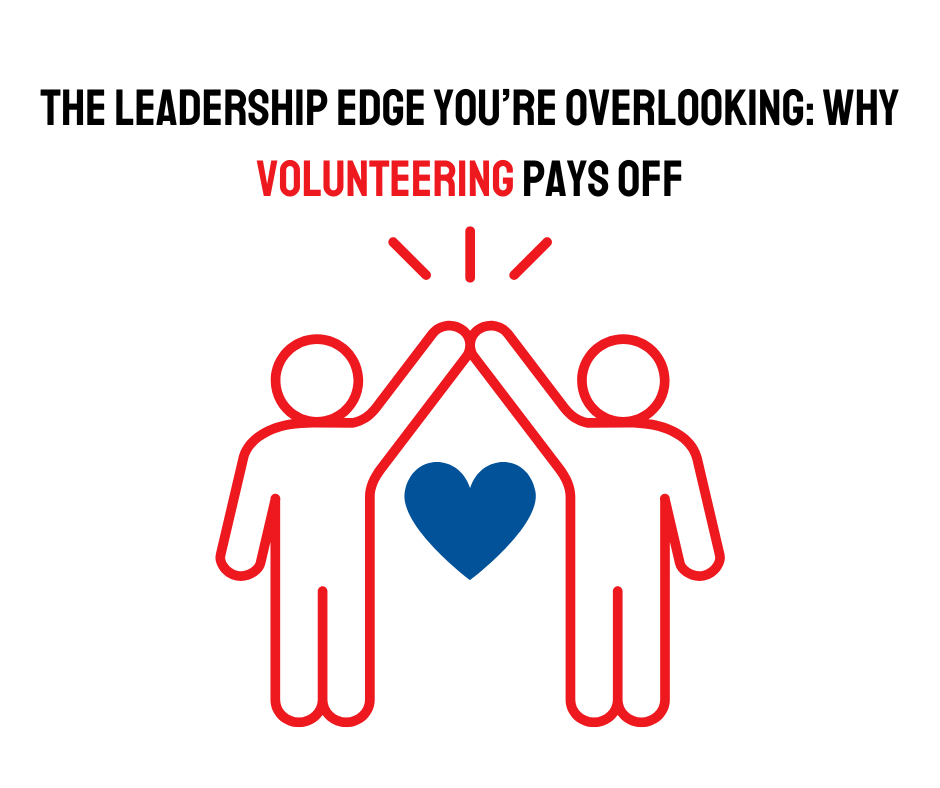
Volunteering builds leadership skills like empathy, strategy, and communication. Giving back enhances employee engagement, company culture, and your network. You don’t need extra time or money—start small, start now. Volunteering often opens doors to unexpected personal and professional growth. Leaders who volunteer are more fulfilled and connected to their communities. 604 words ~ 3 min read In today’s fast-paced business world, leaders are constantly searching for ways to grow—both personally and professionally. But there’s one path to growth that’s often overlooked: volunteering. Volunteering isn’t just about giving back; it’s a leadership accelerator that builds empathy, sharpens strategic thinking, and fosters stronger connections. And the best part? You don’t have to wait until you have “extra” time or resources to get started. Small actions today can lead to profound impacts tomorrow. The Case for Volunteering The personal benefits of volunteering are well-documented. People who volunteer report 27% higher levels of life satisfaction. They experience lower stress and greater emotional well-being ( CNCS ). For professionals and business leaders, the payoff is even greater: Volunteering develops empathy , an essential leadership trait. Serving on nonprofit boards or committees strengthens governance and decision-making skills . Community involvement expands your professional network and boosts your personal brand . Deloitte’s research highlights that employees who participate in workplace volunteer activities are 57% more likely to feel connected to their company’s culture and mission ( Deloitte Volunteerism Survey ). Start Small—But Start Now Many professionals put off volunteering, waiting for the “right” time—when they’re more successful, financially secure, or less busy. But if you wait for perfect conditions, you could be waiting forever. Here’s a simple three-step plan to get started within the next 30 days: Clarify your passion. What causes matter to you—education, health, economic development? Start with what resonates. Leverage your network. Ask colleagues or friends where they volunteer. You’ll be surprised by the connections and opportunities close by. Commit to one small action. Whether it’s one hour a month or lending your skills to a nonprofit’s strategic plan, start with what fits your life right now. What Happens Next May Surprise You Volunteering often leads to unexpected opportunities. You may start by helping at a local event and end up joining a nonprofit board. Or you might discover a passion that redefines your personal mission—or even sparks a career pivot. As Harry Kraemer, former CEO of Baxter International, shares in his leadership insights: “Start small, but be open to where volunteering takes you. Over time, you can grow into roles that allow you to make an even greater impact.” You’ll also become a stronger leader. Volunteering hones key leadership skills: listening, empathy, resilience, and decision-making in complex environments. These are the same traits that set successful business leaders apart. Lead by Example—And Create a Culture of Giving Back If you lead a team or a business, encouraging volunteerism can strengthen your entire organization. Companies that prioritize volunteering experience higher employee engagement, improved morale, and stronger ties to their communities. Consider these steps: Offer paid volunteer days or flexible schedules to encourage employees to give back. Partner with local nonprofits for company-wide volunteer initiatives. Recognize and celebrate volunteer efforts within your team. The Bottom Line Volunteering isn’t just the right thing to do—it’s a leadership strategy that pays dividends. You grow as a leader, build your network, and create lasting positive change. Why wait? Start today. Your future self—and your community—will thank you. Further Reading: Why Volunteering Can Be Great for Business – Harvard Business Review Empathy Is the Most Important Leadership Skill – Harvard Business Review --- The Leavenworth-Lansing Area Chamber of Commerce is a private non-profit organization that aims to support the growth and development of local businesses and our regional economy. We strive to create content that not only educates but also fosters a sense of connection and collaboration among our readers. Join us as we explore topics such as economic development, networking opportunities, upcoming events, and success stories from our vibrant community. Our resources provide insights, advice, and news that are relevant to business owners, entrepreneurs, and community members alike. The Chamber has been granted license to publish this content provided by Chamber Today, a service of ChamberThink Strategies LLC.

Growth isn't a passive process; it doesn’t just happen. Unfortunately, you don’t open a business and sit back and wait for it to grow. Businesses rarely go viral overnight and planning on doing so is like funding your retirement by playing the lottery every week. Business growth is a dynamic journey fueled by strategic thinking and insightful questions that help you see things in new ways. As a business owner, you're constantly navigating challenges and opportunities, not to mention the competition. But are you asking the right questions to propel your business to the next level? Simply working hard isn't enough. We need to work smarter, and that starts with asking the questions that reveal hidden potential and drive meaningful change to attain growth. Internal Questions for Operational Excellence Every successful business rests on a solid foundation. Let's start by looking inward. Are your internal operations optimized for growth? Consider these questions: Are our current workflows efficient, or are there bottlenecks? Take a critical look at your processes. Are there redundant steps or outdated systems that could be streamlined? Are we maximizing our existing resources? This includes your team, technology, and financial assets. Are you leveraging them to their full potential? A lot has changed over the past few years. It may be time to audition new tech and assess the skills gap that may exist in your business. Is our team engaged and aligned with our goals? A motivated team is a powerful engine for growth. Are you providing them with the support and resources they need to succeed? Are they fulfilled in their position? A disengaged employee can do a lot of damage to a business and its service reputation. Actionable Step: Conduct a brief internal audit. Map out your key processes and identify areas for improvement. Schedule a team meeting to gather feedback and brainstorm solutions. External Questions for Market Understanding Understanding your market is crucial for sustained growth. Sometimes markets change or new ones open up. Ask yourself: Who is our ideal customer, and what are their evolving needs? Customer preferences change. Are you staying ahead of the curve? For instance, if you were a business that served authors, with the recent growth in AI, how did that impact them and what they need from you? If you haven’t answered that question in five years, you’re likely behind your competition. Speaking of… What are our competitors doing, and how can we differentiate ourselves? Analyze your competition to identify opportunities to stand out. Again, give them a fresh look. They may be doing new things you weren’t aware of. Additionally, sometimes your competition is not doing anything. If your ideal customer isn’t choosing you, are they choosing your competition or doing nothing? Why? How can we enhance our customer experience to build loyalty and drive referrals? Exceptional customer service is a powerful differentiator. Don’t assume your service is excellent just because you don’t hear complaints. If they’re not talking about you, you’re average. Actionable Step: Conduct a customer survey or analyze your customer feedback data. Research your competitors' online presence and marketing strategies. Strategic Questions for Future Growth Looking ahead is essential for long-term success. Consider these strategic questions: What are our long-term goals, and how can we achieve them? Develop a clear roadmap for the future. What new opportunities can we explore to expand our market reach? Consider new products, services, or markets. How can we innovate and adapt to changing market conditions? Agility is key to staying competitive. Actionable Step: Schedule a strategic planning session with your team. Brainstorm new ideas and develop a plan to implement them. The Power of "Why?" No, this time we’re not talking about YOUR why. Instead, channel your inner four-year-old and don't be content to stop at the surface. Dig deeper by asking "Why?" multiple times. This technique can help you uncover the root cause of problems and identify hidden opportunities. For example, instead of just asking "Why are sales down?" look at the larger picture and ask "Why are sales down? Why are customer leads down? Why is our marketing not generating enough leads?" Use the word “why” and “and” with each question you answer. Your learning and understanding will improve. Your Chamber is Your Partner in Growth Asking the right questions is just the beginning. Your chamber of commerce is here to support you on your growth journey. The chamber offers a range of resources to help you grow including: Networking events to connect with other business leaders Educational workshops and seminars to enhance your skills Access to valuable market data and industry insights Business counseling and mentorship Growth is a continuous process of learning, adapting, and innovating. By asking the right questions and leveraging the resources available to you, you can unlock your business's full potential. Then reach out to your chamber of commerce to explore how it can help you take your business to the next level. --------------- Christina Metcalf is a writer and women’s speaker who believes in the power of story. She works with small businesses, chambers of commerce, and business professionals who want to make an impression and grow a loyal customer/member base. She is the author of The Glinda Principle , rediscovering the magic within. _______________________________________ Medium: @christinametcalf Facebook: @tellyourstorygetemtalking Instagram: @christinametcalfauthor LinkedIn: @christinagsmith
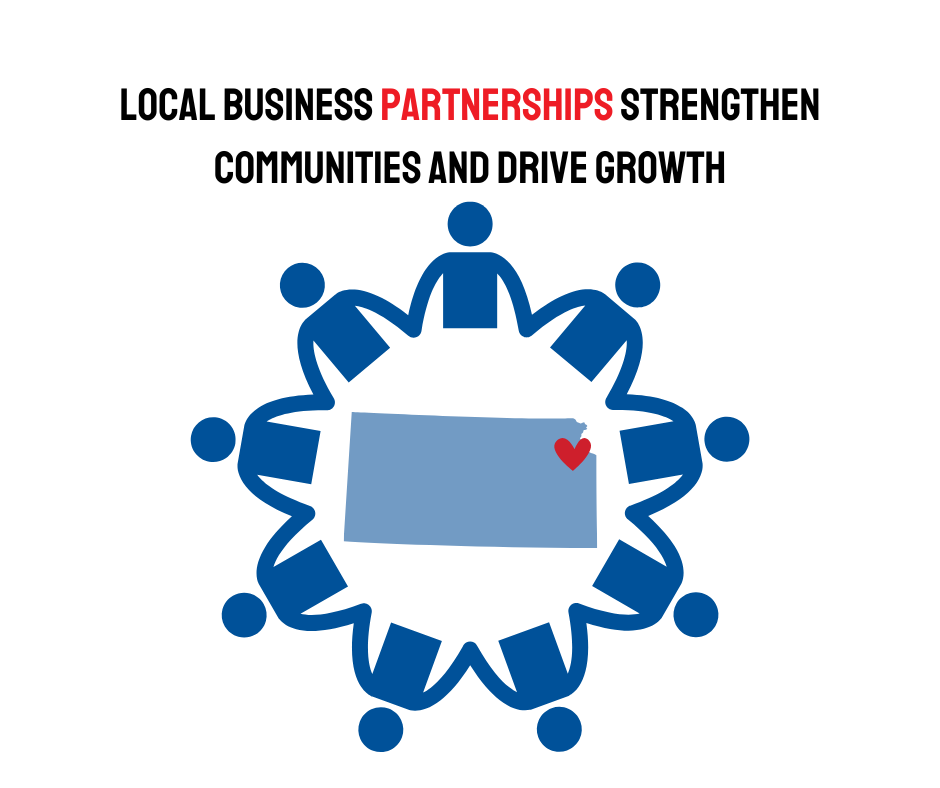
Strategic partnerships expand reach – Small businesses can attract new customers, reduce costs, and strengthen their local presence by collaborating with complementary businesses. Joint events boost visibility – Pop-up shops, community festivals, and charity partnerships create opportunities for cross-promotion and increased customer engagement. Shared marketing maximizes impact – Social media takeovers, email marketing swaps, and joint discounts help businesses reach wider audiences without increasing advertising costs. Co-working and shared spaces reduce expenses – Businesses can lower overhead costs by sharing retail locations, office spaces, or market stalls while enhancing customer experience. Success stories highlight collaboration benefits – Partnerships like breweries and food trucks or bookstores and coffee shops demonstrate how businesses can thrive together by providing complementary services. ~ 507 words / 2.5 min read Small businesses looking to expand their reach and strengthen their customer base are finding success through local collaborations. By forming strategic partnerships with other businesses and organizations, owners can tap into new audiences, reduce costs and contribute to a thriving local economy. Finding the Right Business Partner Successful collaborations often involve businesses that complement, rather than compete with each other. A coffee shop, for example, may partner with a bookstore to host book signings, creating a mutually beneficial arrangement that brings in customers for both. A fitness studio might team up with a health food store to promote wellness programs, offering discounts to each other’s customers. Leveraging Events and Promotions Local businesses can increase visibility and engagement by organizing joint events. Some popular strategies include: Pop-up shops – A bakery can be set up inside a boutique, providing shoppers with refreshments while increasing exposure for both businesses. Community festivals – Restaurants, retailers and service providers can join forces to sponsor or participate in local events, drawing in larger crowds. Charity partnerships – Businesses that collaborate with nonprofits or local organizations not only contribute to a cause but also boost customer loyalty and trust. Such initiatives create opportunities for businesses to cross-promote and introduce their brands to new audiences. Collaborating on Marketing Efforts Marketing can be a significant expense for small businesses, but shared promotional efforts help reduce costs while maximizing impact. Local businesses can work together through: Social media takeovers – Partnering businesses can feature each other on platforms like Instagram and Facebook, increasing engagement. Email marketing swaps – Businesses can promote each other in their newsletters, introducing their products and services to a wider audience. Exclusive discounts – Offering customers a deal when they visit both businesses encourages spending across multiple locations. Exploring Shared Spaces Another effective collaboration strategy involves sharing physical space to cut costs and increase visibility. Co-working environments, pop-up markets and joint retail spaces are becoming increasingly popular among small business owners. For instance, a yoga studio and a wellness clinic might share a lease, offering their clients a one-stop destination for fitness and health. Similarly, food halls that feature multiple vendors allow small restaurant owners to reach new customers without the financial burden of operating a standalone location. Success Stories in Local Collaboration One well-known example of local business partnerships is the collaboration between breweries and food trucks. Many craft breweries lack kitchen facilities, so they invite food trucks to set up outside their establishments. This arrangement brings in more customers, benefits both businesses and creates a vibrant atmosphere for patrons. Independent bookstores and coffee shops have also successfully partnered to attract customers. By allowing book lovers to enjoy a cup of coffee while browsing, both businesses see increased engagement and longer customer visits. The Bottom Line For small businesses, collaboration is more than just a marketing strategy—it’s a way to strengthen the local economy and build lasting relationships with customers. By forming strategic partnerships, hosting events and sharing marketing efforts, businesses can maximize their resources and drive mutual success. --- The Leavenworth-Lansing Area Chamber of Commerce is a private non-profit organization that aims to support the growth and development of local businesses and our regional economy. We strive to create content that not only educates but also fosters a sense of connection and collaboration among our readers. Join us as we explore topics such as economic development, networking opportunities, upcoming events, and success stories from our vibrant community. Our resources provide insights, advice, and news that are relevant to business owners, entrepreneurs, and community members alike. The Chamber has been granted license to publish this content provided by Chamber Today, a service of ChamberThink Strategies LLC.
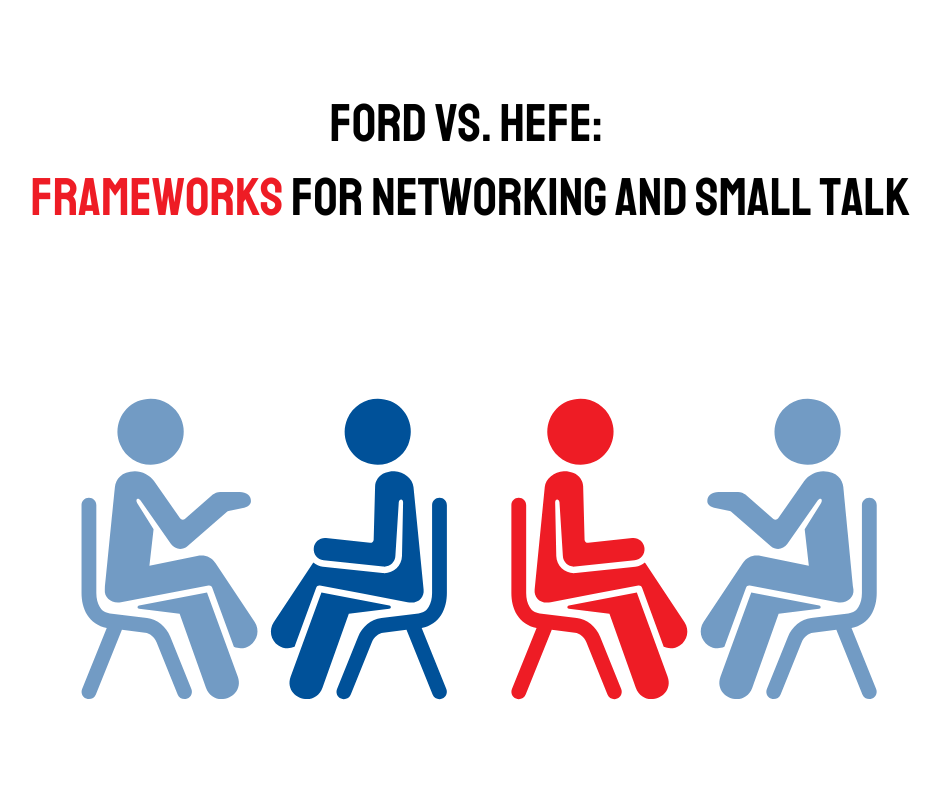
FORD (Family, Occupation, Recreation, Dreams) and HEFE (Hobbies, Experiences, Future, Education) are two frameworks for networking and small talk. FORD focuses on personal and aspirational topics, while HEFE emphasizes shared experiences and individual growth. Use FORD for rapport-building and HEFE for deeper, curiosity-driven conversations. Master both to navigate diverse networking scenarios effectively. ~ 400 words, 2.5 minute read Small talk is the foundation of networking, but it often feels forced or superficial. Frameworks like FORD and HEFE can transform casual conversations into meaningful connections. Let’s explore the strengths and applications of each to help you decide when and how to use them effectively. The FORD Framework FORD stands for Family, Occupation, Recreation, and Dreams . These topics serve as approachable entry points for conversation. Strengths: Universality: Family and work are nearly universal topics, offering familiarity and relatability. Aspiration-oriented: Discussing dreams often leads to uplifting and engaging exchanges. Simplicity: Its structure is easy to remember and apply. Best Use Cases: Quick introductions or casual networking events. Situations where building rapport is more important than diving deep. Example Questions: Did you grow up around here, or did your family move here later? Do you have any big goals or plans you’re working toward right now? What’s your favorite part of your job? The HEFE Framework HEFE stands for Hobbies, Experiences, Future, and Education . This approach shifts the focus to shared interests and personal growth. Strengths: Depth: Encourages meaningful dialogue by exploring unique interests and personal stories. Curiosity-driven: Naturally prompts follow-up questions, sustaining conversation. Relevance: Useful for professional settings, as education and future plans often align with career aspirations. Best Use Cases: One-on-one meetings or smaller networking circles. Situations requiring a balance of personal and professional topics. Example Questions: What do you like to do in your free time? Did you have a favorite teacher or mentor who inspired you? Do you spend time with extended family, or do you live close to them? Key Differences Focus: FORD emphasizes rapport-building through relatable topics, while HEFE dives deeper into individuality and curiosity. Tone: FORD is light and conversational; HEFE leans more reflective and intellectual. Adaptability: FORD works well for short, casual interactions, whereas HEFE is better suited for in-depth conversations. How to Use Them Together The most effective networkers combine these frameworks, adapting to their audience and setting: Start with FORD: Break the ice by asking about family, work, or hobbies. Transition to HEFE: Once rapport is established, steer the conversation toward experiences or future goals to deepen the connection. Bottom Line Both FORD and HEFE are valuable tools for networking, but the key to success lies in understanding your audience and the context. Whether you’re attending a large event or engaging in a one-on-one chat, these frameworks provide reliable strategies to connect, communicate, and leave a lasting impression. --- The Leavenworth-Lansing Area Chamber of Commerce is a private non-profit organization that aims to support the growth and development of local businesses and our regional economy. We strive to create content that not only educates but also fosters a sense of connection and collaboration among our readers. Join us as we explore topics such as economic development, networking opportunities, upcoming events, and success stories from our vibrant community. Our resources provide insights, advice, and news that are relevant to business owners, entrepreneurs, and community members alike. The Chamber has been granted license to publish this content provided by Chamber Today, a service of ChamberThink Strategies LLC.
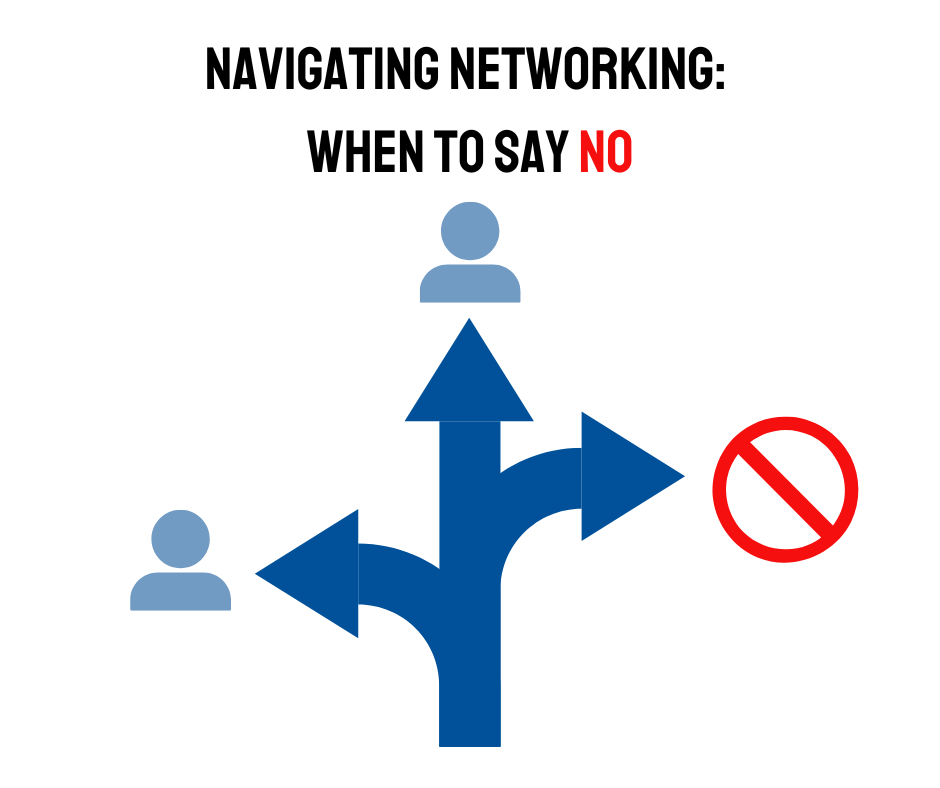
Not every networking invitation is worth your time. Watch for red flags: 1️⃣ A pitch, not a relationship. 2️⃣ Questionable reputation. 3️⃣ Asking for help too soon. 4️⃣ Past negative interactions. Decline respectfully, and prioritize meaningful connections. 456 words ~ 2.5 minute read --- Early in your career, you might feel pressured to seize every networking opportunity, thinking it’s the key to success. But not all connections are created equal. Investing time in the wrong relationships can detract from building meaningful, productive networks. Knowing when to decline a networking request is essential for preserving your energy and integrity. Here are key red flags to consider before saying yes: It’s a Sales Pitch, Not a Relationship If someone approaches you with an agenda to sell a product or service rather than foster a genuine professional connection, be cautious. Authentic networking should be about mutual growth and shared value—not transactional gains. Reputation Raises Concerns If the individual or their organization has a questionable reputation or operates in a way that conflicts with your values, engaging could jeopardize your professional credibility. It’s okay to protect your integrity by steering clear. Premature Requests for Favors When someone asks for significant help or endorsements before you’ve established any rapport, it’s a sign they’re likely prioritizing their interests over yours. Genuine connections develop over time and mutual effort. Negative Past Interactions If you’ve previously engaged with someone and it left a bad taste—be it unprofessionalism, unreliability, or other red flags—there’s no need to give them a second chance. Trust your past experiences to guide future decisions. The Art of Declining Turning down a request doesn’t have to damage relationships. Politely declining with gratitude for the invitation and offering alternative resources or contacts can soften the refusal. A simple response like, “Thank you for reaching out, but I’m unable to commit at this time. Best of luck!” goes a long way in maintaining professionalism. Building Intentional Connections Focus your networking efforts on individuals and groups aligned with your professional goals, values, and vision. Seek out mentors, peers, and collaborators who inspire growth and offer reciprocal value. By being selective, you’ll maximize the impact of your relationships and create a network that fuels your career. Further Reading: The Dos and Don’ts of Networking (Harvard Business Review) How to Master Meaningful Connections (Forbes) --- The Leavenworth-Lansing Area Chamber of Commerce is a private non-profit organization that aims to support the growth and development of local businesses and our regional economy. We strive to create content that not only educates but also fosters a sense of connection and collaboration among our readers. Join us as we explore topics such as economic development, networking opportunities, upcoming events, and success stories from our vibrant community. Our resources provide insights, advice, and news that are relevant to business owners, entrepreneurs, and community members alike. The Chamber has been granted license to publish this content provided by Chamber Today, a service of ChamberThink Strategies LLC.
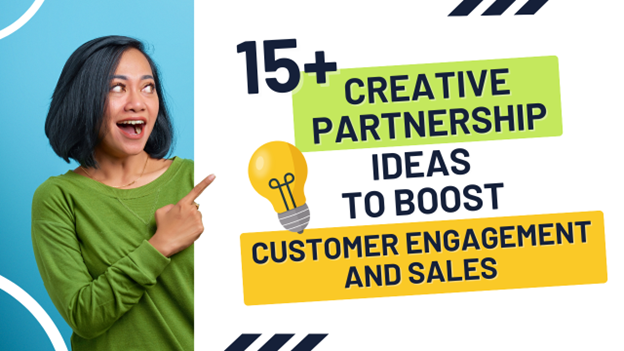
In my town, businesses of all types and industries are getting into the event business. They’re offering how-to demos, social gatherings, night outs, and a lot more. Best of all, they’re collaborating with some unlikely partners. Using a similar type of collaboration can help you reach new audiences, enhance your offerings, and drive sales. Here are 15 innovative partnership ideas that can benefit small businesses across various industries. Even if you don’t see your industry in the list below, you can use these ideas to get thinking about what businesses could be good referral (and joint event) partners for you. Remember, the more creative, the better. You don’t need to be in complementary industries, you just want to find another business who may share a similar (but not the same) audience. You can also ask yourself, “what would my audience want that is not in direct competition with what I do?” Here's what’s going on in my area: · Bars pairing with floral designers—create your own floral arrangement (with the help of a pro) while you enjoy a beverage or two. · Bookstore hosting an event at a wine bar—because readers and writers like to drink. · Metaphysical speakers at a local organic product store. · Yoga studio pairing with the local nature preserve. · A toy store, ice cream vendor, and a local park creating a pop-up event for preschoolers That’s just the beginning. Here are a few other ideas of what you might do with a newfound pairing: 1. Fitness Studio and Health Food Store Joint Events and Programs . Host wellness workshops, nutrition seminars, or fitness challenges together. The fitness studio can offer workout classes, while the health food store provides healthy snacks and nutrition advice. Referral Program . Offer discounts to each other’s customers. Newsletter Guest Appearances . Feature each other in newsletters, blogs, or in videos, sharing health tips, recipes, and fitness advice to engage both audiences. 2. Art Gallery and Local Café Art Exhibitions and Coffee Tastings . Organize art shows at the café, where patrons can enjoy local artwork while sipping on specialty coffee. The art gallery can also host coffee tastings during their exhibitions. Social Media Collaborations . Share each other’s events and promotions on social media, attracting art lovers and coffee enthusiasts alike. Customer Loyalty Programs . Offer a discount where customers at both businesses receive a discount on the other or special gift for visiting. 3. Pet Grooming Salon and Pet Supply Store Pet Care Workshops . Host workshops on pet grooming, nutrition, and training. The grooming salon can demonstrate grooming techniques, while the pet supply store offers products and advice. Cross-Promotions . Feature each other’s services and products in-store and online. For example, the grooming salon can promote special offers on pet supplies, and the pet supply store can highlight grooming packages. Community Events . Organize pet adoption events or charity drives for animal shelters, enhancing both businesses’ community involvement and visibility. 4. Yoga Studio and Organic Skincare Shop Wellness Retreats . Collaborate on wellness retreats or day-long events that combine yoga sessions with skincare workshops and organic product samples. In-Store Pop-Ups . The skincare shop can set up a pop-up at the yoga studio to sell products and provide skin consultations after classes. Joint Social Media Campaigns . Share wellness tips, yoga poses, and skincare routines on social media, reaching a broader audience interested in holistic health. 5. Toy Store and Children’s Bookstore Storytime and Play Sessions . Host joint events where kids can enjoy story time readings followed by play sessions with toys related to the stories. My local bookstore does “Stuffy Stories,” where guests are welcome to bring their favorite stuffed animals to enjoy the story too. You could easily incorporate this idea with a local toy store discount coupon for attending. Holiday Gift Guides . Create and share holiday gift guides featuring toys and books, helping parents find the perfect presents while promoting both stores. 6. Wine Store and Caterer/Restaurant Wine Pairing Dinners . Collaborate on wine pairing dinners where the restaurant provides a gourmet meal paired with wines selected by the wine store. Tasting Events . Host joint tasting events, offering samples of wines and appetizers from the restaurant, attracting food and wine enthusiasts. Cross-Promotions . Feature each other’s offerings in-store and online. The wine store can promote the restaurant’s events and vice versa, enhancing visibility for both businesses. 7. Bike Shop and Outdoor Adventure Company Guided Bike Tours . Organize guided bike tours that explore local trails and scenic routes. The bike shop can provide equipment, while the adventure company leads the tours and offers outdoor expertise. Workshops and Clinics . Host workshops on bike maintenance and outdoor survival skills, attracting cycling enthusiasts and adventure seekers. Referral Incentives . Offer referral incentives where customers who purchase a bike get a discount on adventure trips, and vice versa. 8. Bakery and Flower Shop Bridal Showers and Events . Partner to host bridal showers, weddings, and other events where the bakery provides cakes and pastries, and the flower shop offers floral arrangements. Seasonal Promotions . Create seasonal promotions with themed baked goods and floral arrangements, such as Valentine’s Day packages or holiday gift baskets. Customer Appreciation Days . Host customer appreciation events with complimentary samples of baked goods and small floral bouquets, thanking loyal customers of both businesses. 9. Photography Studio and Event Planner Wedding Packages . Offer comprehensive wedding packages that include photography services and event planning, providing a one-stop solution for couples. Joint Marketing Efforts . Feature each other’s services in brochures, websites, and social media, showcasing how the collaboration enhances the overall event experience. Referral Program . Establish a referral program where each business refers clients to the other, with discounts or bonuses as incentives. 10. Music School and Instrument Store Music Workshops . Host music workshops and masterclasses where the music school provides instruction, and the instrument store showcases and sells instruments. Concert Series . Organize a concert series featuring students from the music school performing with instruments from the store, drawing in audiences from both customer bases. Collaborative Content . Create and share content such as tutorials, instrument care tips, and performance videos on social media and YouTube, engaging and educating followers. More Creative Collabs 1. Custom furniture maker and interior design studio 2. Vintage clothing store and record shop 3. Local theater and fine dining restaurant 4. Herbal tea shop and yoga retreat center 5. Artisan chocolate shop and wine bar By forming creative partnerships with other businesses, you can leverage each other’s strengths to attract new customers, enhance their offerings, and drive sales. If you don’t know who to partner with, ask your local chamber. They can help you find a complementary business with shared values and goals, and make the introduction for you. ------------ Christina Metcalf is a writer/ghostwriter who believes in the power of story. She works with small businesses, chambers of commerce, and business professionals who want to make an impression and grow a loyal customer/member base. She loves road trips, hates exclamation points, and is currently reading three books at once. _______________________________________ Medium: @christinametcalf Facebook: @tellyourstorygetemtalking Instagram: @christinametcalfauthor LinkedIn: @christinagsmith



